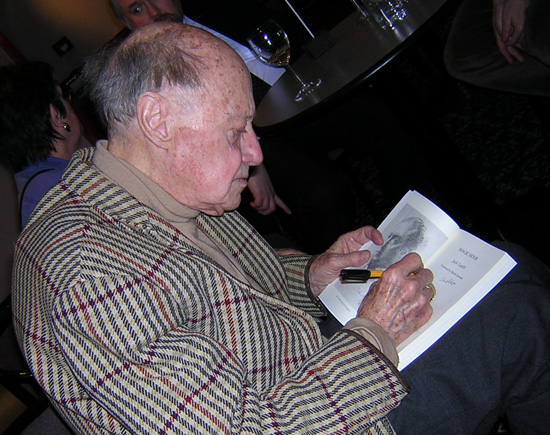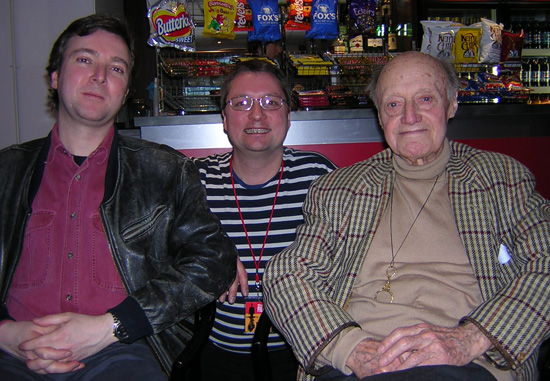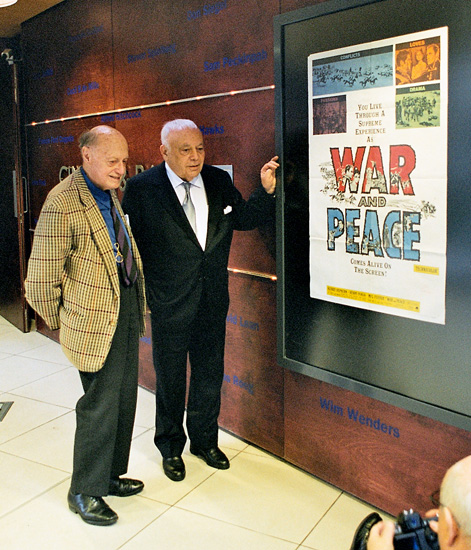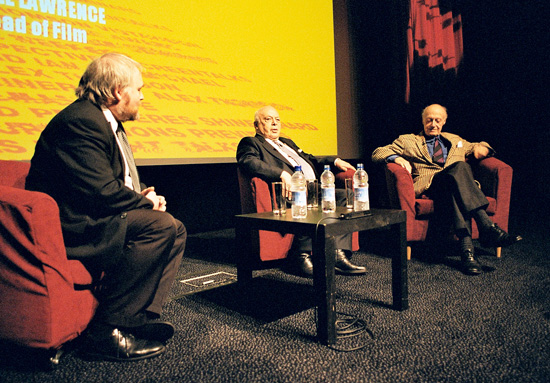Jack Cardiff about "Scent of Mystery" |
Read more at in70mm.com The 70mm Newsletter |
| Written by: Recorded in 1986, in reply to Miss Tammy Burnstock, Writer & Producer, Australia. Retyped for in70mm.com by Anders M Olsson | Date: 01.01.2016 |
 Jack
Cardiff in Bradford, 2004 signing autographs during The Wide Screen Weekend.
Image by Thomas Hauerslev Jack
Cardiff in Bradford, 2004 signing autographs during The Wide Screen Weekend.
Image by Thomas HauerslevHello Miss Burnstock. By some ironic fate you have chosen a subject, the film I directed: "Scent of Mystery", which is the one film I want to erase from my memory. The reason for this is that, through no fault of my own, the film was a complete disaster. It was a great idea in the beginning, and using smells in a film was also an ambition I had had for years. Shooting the film was exciting and we were all convinced we had a great movie. Shooting all over Spain- it was great stuff. Then about half way through I said to Mike Todd Jr., who was of course the Producer, over a lunch, "I suppose you have smelt some of the effects from Hans Laube, some samples for instance?" "As a matter of fact" said Michael, "I haven't. I guess we should send for some samples shouldn't we." So he wrote to Hans Laube in Switzerland, and some weeks after we received a small box with samples of various smells which were important to the picture, like tobacco, the sea, apricots, things like that. And we opened each glass vial and sniffed. Well it's hard to believe but each labelled glass smelled exactly the same as the others- like a very cheap eau de cologne. Well I'll try to remember as much as I can to answer some of your questions, but it is a long time ago- it's twenty six years ago, isn't it? How did I come to direct 'Scent of Mystery'? Well, I had quite a success on a previous film, "Sons and Lovers", and I suppose the natural thing... I had met Mike Todd's father who died, as you know, in a tragic air accident. And he had wanted me to direct "Don Quixote". But nothing finally came of it because he died soon after that. But I was automatically chosen for 'Scent of Mystery'. As I say, I was very pleased because it was something that had interested me for years- and I still have an interest in it. But it was such a sad thing that the film was made... as integral part of the film was of course the use of smells, and it didn't come off because the smells were nothing, they were a fake. What happened... When we finished the picture, as you can imagine, I was a bit worried, and I think Mike Todd was too- that what we'd smelt so far was just very cheap perfume and no difference in them. But what happened was we shot it in wide film, very wide film: six five, and as well as the sound track on the side of the film, there was a special narrow track which was like a cue guide for when a smell was expected on the screen. And it was quite an extraordinary set up. We went for a first running to Chicago- a big Cinema in Chicago where they had prepared for the first running. And they had fixed a huge vat or series of vats with various smells in them underneath the theatre, and there were pipes, small pipes, running to every seat in the audience, which is quite a feat. And what happened was that the pipes would be run up the back of each seat so that the person behind you would get the whiff of a smell as it was injected into the pipes, as the track- the smell track- gave off a signal, a cue. So it would release the smell which would go through the pipes and took so many seconds, and it worked very well: exactly on cue you'd get the whiff of the smell coming up from the seat in front of you, so you'd smell it. |
More in 70mm reading: MP3: Listen to Jack Cardiff's voice, when he read this article in 1986 Scent of Mystery lives again! A Brief History about Hans Laube Letters and Dust Devils My father never really talked about the motion picture business Oliver Michael Todd in Conversation Mike Todd, Jr. Interview Mike Todd Jr.'s "Scent of Mystery" in Smell-O-Vision Working for Michael Todd Paul Rayton Remembers "Scent of Mystery" in 3 minutes and 49 seconds Internet link: |
 Jack
Cardiff in Bradford, 2004. Jack loved to talk about "The African Queen" and
many were eager listeners to his stories. Jack with admires Sheldon Hall and
Thomas Hauerslev in the middle. Image by Mark Lyndon Jack
Cardiff in Bradford, 2004. Jack loved to talk about "The African Queen" and
many were eager listeners to his stories. Jack with admires Sheldon Hall and
Thomas Hauerslev in the middle. Image by Mark LyndonThe technical part was excellent but when we ran the film in Chicago (laughs) for the press and everybody, they all said the same thing: there is no particular smell about anything. It was all a kind of cheap eau de cologne. This was a disaster. And then later on we ran it in New York, and that was the end of that because it had terrible notices because it was not a genuine Smell-O-Vision at all. It was a very interesting story with a marvellous photographic background of Spain, but the smell, for which it was made, didn't exist. The storyline of "Scent of Mystery" - it would take a long time to sort of gather it up, but it was a kind of hunt for some particular woman in the story, and as Elizabeth Taylor, being the wife of Michael Todd who had died, had a kind of supervising interest in the company, she agreed to appear at the very end of the story as the mystery woman. Which we did. And we shot her... I think it was only one days shooting. I'd taken her out to dinner the night before and she was very charming, and as I say it was all very promising as a subject matter, but it simply didn't work out without the smells of course. Yes, the film was written specifically for Smell-O-Vision in the sense that each dramatic point was woven into the actual presence of a smell. And funnily enough I had thought of a Whodunnit before the film was made, years before. I had thought how interesting it would be to have a Whodunnit film where if the murderer... we knew the murderer smoked a certain type of tobacco. If you were in a room which was empty, and if you smelt the smell of tobacco coming in, you'd know that the murderer would be coming into the room. It's as simple as that. And in fact on "Scent of Mystery" we did have- I assume that you have seen the film- that that was a kind of climax: the smell of tobacco (laughs). If one had smelt the tobacco. It was written specifically for these effects. We had so many scents that were supposed to be, but it's difficult to remember... when you say "can you tell me about some of the scents incorporated?" As I say there were no scents that came up because of this phony gentleman that didn't provide the scents. But we had all kinds of scents. Tobacco was a strong one, and the sea was supposed to be a strong one, and lots of different perfumes that came through, and there was one sequence where there was a fight in the ladies bedroom and they threw things at each other. All kinds of things like perfume bottles and talc powder and things, and as they hit people you'd smell the scents. And that would have been a very good... all this is 'would have been' if only the smells had worked out. |
|
 Jack
Cardiff and Herbert Lom in Bradford, 2004. Image Thomas Hauerslev Jack
Cardiff and Herbert Lom in Bradford, 2004. Image Thomas HauerslevI found working with Michael Todd Jnr very well. He was very earnest and eager to learn all he can, and he had a very... he had his father's business acumen. And we did some very good shots with him. I never met Hans Laube. And I know nothing about him at all. He disappeared from all knowledge when the film was finished. I don't know whether Michael Todd tried to sue him or not, or whether he just took it on the chin. There were all kinds of rumours about the film afterwards. A very funny thing happened. Of course the hero in the picture was Denholm Elliott. And when the film... before the film was made we were casting the film, and Michael was asking who did I think could play the part of this young man, and I said that I knew a man who was not a star but he was a very brilliant impersonator, and his name was Peter Sellers. Of course he'd been unknown at that time, absolutely unknown, and I took Peter Sellers to lunch at the Dorchester to meet Michael Todd. And we went, actually upstairs to Michael Todd's room. And then we went down to lunch. Now, like a lot of great comedians, when you meet them in real life they're not at all funny, they're very serious people. And Peter Sellers was shy and very serious. And we had lunch and after he'd gone Michael Todd Jnr said "I don't think much of him, he's not a bit funny." And we didn't have him. And years later I had a letter from Michael Todd saying if only he'd taken my advice what a different story it might have been. It's very interesting because Peter Sellers, of course, became very famous. I can tell you one thing that happened during the picture which was not at all pleasant. We were about two thirds through the picture and apart from Denholm Elliott there was Peter Lorre whom you might remember. He was quite famous and he was a very fat man with big rolled eyes, wide staring eyes, with this German or Viennese accent. He played the cab driver, and as I say, towards two thirds of the picture I went out to dinner and half way through dinner my assistant, the assistant director, came up to me, found me in the restaurant and said "Jack. Peter Lorre is dying." And that of course was a shock. And I went round to his hotel and there were a lot of doctors round the bed, all shaking their heads saying they gave him about an hour - no more - and then he would be dead. And Peter was lying on his back on a kind of rather hard bed in the centre of the room, breathing in the most dreadful manner, in sort of spasmodic jerks- sort of (imitates) like that. And he was rather... he reminded me of a toad, a big toad. And his breasts were going up and down in a terrible uneven way, and obviously they didn't see much hope for him. And it was in the town of Cordoba which was a town which was renowned for surgeons- they had all these surgeons around the bed. And one of them suggested that they resorted as a last gamble on the old fashioned Letting of blood principle. And this they did. They cut an artery and... or they cut a vein and let off a lot of blood, and in some incredible way it worked. It quieted him down and he was sort of... he was breathing a bit easier, and that was about ten o'clock at night. And then about um... as we stayed up all night looking at him. About three or four in the morning he started to talk in French, and by five in the morning he was conscious. Well, the doctors said that he would live but of course he mustn't do any exercise and must be very careful: he could only walk very slowly. And at that time, at that part of the movie he had to be running, running around the cliffs and down paths and everything, so we had to have a double. And we advertised all over Madrid for a perfect double, and amazingly enough we found one; we found someone who looked exactly like Peter Lorre. And he did all the running in the picture, and then when it came to the end of it and he had to stand still and speak, we put in Peter, the real Peter Lorre. But it was touch and go, because if we'd lost him we would have had to start the picture virtually all over again. About five years ago the film came to London having been revised a little bit, but not much. And of course it was showing in London, the Coliseum, without any smells at all, it just had music. And it was sad because it was... made to incorporate smells and there were no smells at all, so it was just like a very old any film. And I was very sorry about it, very bitter with the people... the man who had caused all this tragedy. And that was that. It has run all over the world in odd places, but it was nothing like the success it should have been. |
|
 Jack
Cardiff and Herbert Lom in Bradford, 2004 being interviewed by Head of Film,
Bill Lawrence. Image Thomas Hauerslev Jack
Cardiff and Herbert Lom in Bradford, 2004 being interviewed by Head of Film,
Bill Lawrence. Image Thomas HauerslevI forgot to mention that the final rubbing of salt in the wound was, when the film was released in New York- when it came out, had its premiere in New York, I forget who it was... Some enterprising company had installed one or two smells in the circuit, the cooling circuit in the theatre and they called their film the first authentic Smellie. Which was existing just a few days before our film came out, so that was rather sad too. But that had a lot of advert... and of course it worked in the sense that one or two smells put into the air vents would smell and people would associate it with the ideas of the first Smellie. I remember many years ago before this whole thing came up... I think one of the reasons I was interested in smells in films was that I had been to a show, a theatre show in London and they had had a kind of Turkish scene or Eastern scene with a Harem or something like that, and over the stage effects they'd released a lot of incense, and it had a powerful effect on me, to see these people in an eastern setting with the smell of incense, and I always felt from then on that it had a future. Frankly I think it has a future today. I think sooner or later someone will get around to doing it properly. Of course one of the drawbacks with the whole idea, if you say something about a Smell-o-vision, the listener frequently giggles and says "Oh, what about if you... what happens if you made a film with a lavatory in it." And it's nonsense because you don't have to do that. Just like you don't have to show a lavatory visually on the film- it's not important. But there's a lot of prejudice against smells in the theatre simply because they think of horrid smells, they think of all sorts of ugly smells. As I say I think there is a future: when it will come I don't know. I hope it will come soon because I would be interested in doing it again. Well, that's all the things I can think of to tell you and I wish you the best of luck on your paper. And I would like to have heard it. Anyway, as I say, all the very best of luck to you. Listen to Jack Cardiff's voice, when he read this article in 1986 |
|
| Go: back - top - back issues - news index Updated 22-01-25 |
